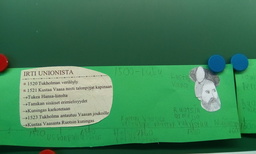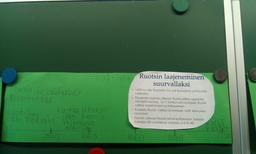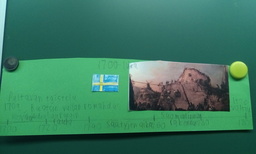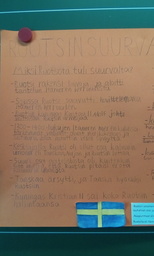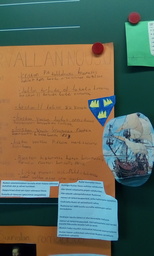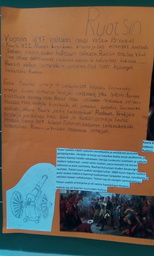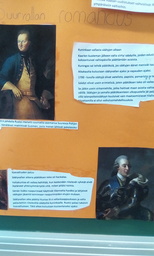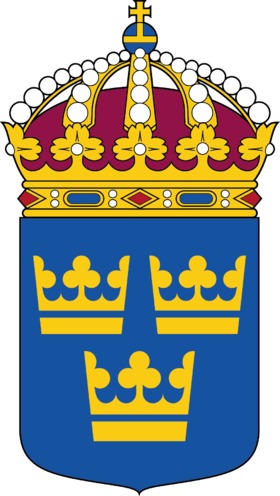Ruotsin suurvallan nousu ja tuho
Jakson kertauskoe
Test on Ruotsin suurvallan nousu ja tuho
24. Säätyvaltaa ja itsevaltiutta
From the power of the king at the time of the estates (s.144)
Due to the expeditions, the state had become impoverished and hundreds of thousands of people had died. Everything was blamed on the king who did not take care of his people. No one wanted to experience the same again.
After Charles' death, power passed to the statutes, whose representatives met in the parliament to decide matters. It was up to the king to sign the decisions and stamp the documents. The king was only allowed to make decisions if the voices of the estates were equal. The king was mocked as the stamp king. The age is called the time of estates and the time of freedom.
The estates of the 18th century were the nobility, the clergy, the bourgeoisie, and the peasants. The estates sent their representatives to the parliament, which met in Stockholm every three years. In the parliament, each ordinance had only one vote. The decision required the votes of three statutes. The estates were often divided, so decision-making was difficult. Indeed, it was often left to the officials who took care of the country’s affairs between parliaments. A lot of people were left out of the estates and at the same time decision-making, because the peasant estate included only the landowners. The landless had no influence.
The return of autocracy (s. 146)
It is August 21, 1772. Gustav III, who served as the Stamp King, has invited representatives of the estates to the Parliament. Tired of the confusion of regulatory power, the confident king is determined to return the king to the pinnacle of power. He declares to the estates that he is the king who unites the people from the dispersal of the dispensation. Gustav III promises to restore the king's esteem to the level it was at the time of his ancestor Gustav II Adolf. The estates accept the royal proclamation and relinquish power. They have no choice, for only a moment earlier the king had ordered the imprisonment of the most important officials. In addition to the army, the king has also gained control over a people tired of his rule.
During the legislature, decision-making was difficult. It was difficult to develop the kingdom when conflicting groups could not find a consensus on how to act. In addition to this, neighboring countries took advantage of the situation and donated members of the estates to act in the interests of neighboring countries. The time of the ruling power ended with the coup of Gustav III, and power was restored from the disputed estates to the king. Sweden returned to sovereignty. This time is called the Gustavian period.
Gustav III renewed his kingdom, so he can be considered an enlightened autocrat. He allowed freedom of religion, eased penalties for the benefit of citizens, and founded numerous new cities, such as Tampere and Kuopio. He also liked art and culture and built buildings in line with the latest styles. Gustav III had received a good education and took the model of France in everything, which he considered the cradle of world civilization.
Surprise in disguise (s. 147)
It is March 16, 1792. The Stockholm Opera House celebrates masquerades, which have also been attended by a culture-loving king. He has been in power for twenty years. The nobility, disappointed in the king, has a plan. They are going to kill the king. The unsuspecting king enjoys the atmosphere and serving of a masquerade evening. The feast is interrupted for a moment when the king receives a message informing him of the intentions of the nobility. However, the confident king does not care about the threat and decides to enjoy the evening in the normal way. Among the guests is Jacob Johan Anckarström, who uses his mask to get close to the king, greet politely and shoot the king with a pistol under his cloak. The wounded king dies from his injuries two weeks later.
Although Gustav III developed the kingdom, not all were pleased with autocracy. During the estates, the nobles had been able to influence the affairs of the land, so they were annoyed by the loss of power. The people, on the other hand, were disturbed by the king’s abundant lifestyle, for at the same time their own daily lives were filled with hard work and poverty. However, the assassination did not restore power to the ordained, but an authoritarian kingdom was inherited from Gustav's eldest son.
1. What were the estates of the 18th century?
2. Who was left out of the estates in the 18th century?
3. Explain what they mean
a) the period of freedom (vapauden aika)
b) the stamp king (leimasinkuningas)
c) the parliament (valtiopäivät)
d) the Gustavian period. (kustavilainen aika)
4.
a) How were decisions made during the time of freedom?
b) Why was decision-making difficult during freedom?
c) Why did Gustav III want to restore power to the king?
Due to the expeditions, the state had become impoverished and hundreds of thousands of people had died. Everything was blamed on the king who did not take care of his people. No one wanted to experience the same again.
After Charles' death, power passed to the statutes, whose representatives met in the parliament to decide matters. It was up to the king to sign the decisions and stamp the documents. The king was only allowed to make decisions if the voices of the estates were equal. The king was mocked as the stamp king. The age is called the time of estates and the time of freedom.
The estates of the 18th century were the nobility, the clergy, the bourgeoisie, and the peasants. The estates sent their representatives to the parliament, which met in Stockholm every three years. In the parliament, each ordinance had only one vote. The decision required the votes of three statutes. The estates were often divided, so decision-making was difficult. Indeed, it was often left to the officials who took care of the country’s affairs between parliaments. A lot of people were left out of the estates and at the same time decision-making, because the peasant estate included only the landowners. The landless had no influence.
The return of autocracy (s. 146)
It is August 21, 1772. Gustav III, who served as the Stamp King, has invited representatives of the estates to the Parliament. Tired of the confusion of regulatory power, the confident king is determined to return the king to the pinnacle of power. He declares to the estates that he is the king who unites the people from the dispersal of the dispensation. Gustav III promises to restore the king's esteem to the level it was at the time of his ancestor Gustav II Adolf. The estates accept the royal proclamation and relinquish power. They have no choice, for only a moment earlier the king had ordered the imprisonment of the most important officials. In addition to the army, the king has also gained control over a people tired of his rule.
During the legislature, decision-making was difficult. It was difficult to develop the kingdom when conflicting groups could not find a consensus on how to act. In addition to this, neighboring countries took advantage of the situation and donated members of the estates to act in the interests of neighboring countries. The time of the ruling power ended with the coup of Gustav III, and power was restored from the disputed estates to the king. Sweden returned to sovereignty. This time is called the Gustavian period.
Gustav III renewed his kingdom, so he can be considered an enlightened autocrat. He allowed freedom of religion, eased penalties for the benefit of citizens, and founded numerous new cities, such as Tampere and Kuopio. He also liked art and culture and built buildings in line with the latest styles. Gustav III had received a good education and took the model of France in everything, which he considered the cradle of world civilization.
Surprise in disguise (s. 147)
It is March 16, 1792. The Stockholm Opera House celebrates masquerades, which have also been attended by a culture-loving king. He has been in power for twenty years. The nobility, disappointed in the king, has a plan. They are going to kill the king. The unsuspecting king enjoys the atmosphere and serving of a masquerade evening. The feast is interrupted for a moment when the king receives a message informing him of the intentions of the nobility. However, the confident king does not care about the threat and decides to enjoy the evening in the normal way. Among the guests is Jacob Johan Anckarström, who uses his mask to get close to the king, greet politely and shoot the king with a pistol under his cloak. The wounded king dies from his injuries two weeks later.
Although Gustav III developed the kingdom, not all were pleased with autocracy. During the estates, the nobles had been able to influence the affairs of the land, so they were annoyed by the loss of power. The people, on the other hand, were disturbed by the king’s abundant lifestyle, for at the same time their own daily lives were filled with hard work and poverty. However, the assassination did not restore power to the ordained, but an authoritarian kingdom was inherited from Gustav's eldest son.
1. What were the estates of the 18th century?
2. Who was left out of the estates in the 18th century?
3. Explain what they mean
a) the period of freedom (vapauden aika)
b) the stamp king (leimasinkuningas)
c) the parliament (valtiopäivät)
d) the Gustavian period. (kustavilainen aika)
4.
a) How were decisions made during the time of freedom?
b) Why was decision-making difficult during freedom?
c) Why did Gustav III want to restore power to the king?
Hatut or myssyt?
In the parliament, the representatives were divided into two groups. One of them eagerly wanted to bring Sweden back to great power, even if it meant a new war. This group was called hatutu after their triangular hats. Another group wanted a calmer policy. They were called myssyt after their own headdress mold. Both groups tried to get a majority of the representatives of each statute on their side.
Hatut and Myssyt disagreed on almost everything related to the care of the kingdom. This is well illustrated by the fact that hatut mocked myssyt as yömyssyt (night caps), as these supposedly did not understand anything about state care, i.e., wore a hat with their eyes in their sleep when important decisions were made.
The hatut came to power in 1741 started a war against Russia to restore the Swedish superpower. Sweden did not succeed, and Russia occupied Finland for two years. This war is called the war of hats.
Aikajana
Ruotsin suurvallan nousu
Ruotsin suurvallan romahdus
Ruotsin pieni vaakuna
Ruotsi nousi suurvallaksi 1600-luvulla ja menetti suurvalta-asemansa 1700-luvun alussa.
